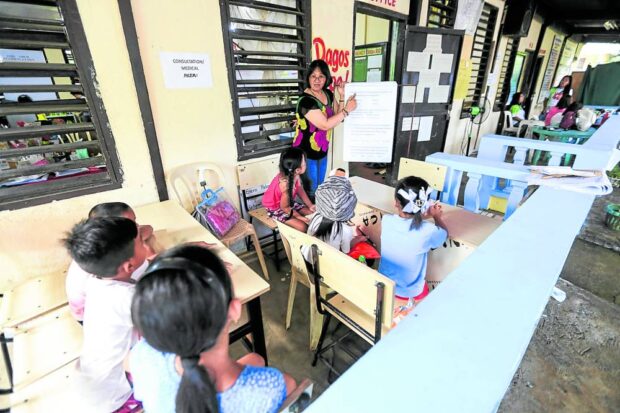Mayon evacuees hit 20,000; price freeze on in Albay

CONTINUOUS LEARNING As Mayon Volcano “bleeds” Thursday night, a teacher at Taladong Elementary School in Camalig, Albay, remains undeterred, holding a class for some evacuees earlier that day. PHOTO BY MARK ALVIC ESPLANA
MANILA, Philippines — More than 20,000 residents in Albay province have now been evacuated amid Mayon Volcano’s continuing unrest, the National Disaster Risk Reduction and Management Council (NDRRMC) said on Friday.
The volcano is “currently in a relatively high level of unrest as magma is at the crater and hazardous eruption within weeks or even days is possible,” the Philippine Institute of Volcanology and Seismology (Phivolcs) said in its bulletin on Friday morning.
According to the NDRRMC’s latest advisory, 20,267 residents from Albay’s 26 barangays have been transferred out of the volcano’s critical areas, with 18,584 of them now staying in 27 evacuation centers.
But the total number of affected persons as of Friday was higher, at 38,391, the NDRRMC said.
Its bulletin also showed that a total of P57.6 million in assistance has been provided by various government agencies.
Article continues after this advertisement‘Extreme scenario’
“So far, we are only addressing the adequacy of the evacuation centers. Our next challenge is to provide potable water, clean facilities and other related needs at the evacuation centers,” NDRRMC spokesperson Assistant Secretary Bernardo Alejandro IV said in a TV interview.
Article continues after this advertisementThe Office of Civil Defense said it is planning to establish permanent evacuation centers for residents living within Mayon’s danger zone.
“As much as possible we should build new places that they could stay in or more permanent evacuation centers where they can stay temporarily,” Office of Civil Defense spokesperson Diego Mariano said at Friday’s Laging Handa briefing.
The provincial government is urging the estimated 25,000 residents still within the extended danger zone to prepare to leave if the volcano’s alert status is raised to level 4.
On June 12, Albay Gov. Edcel Greco Lagman extended the danger zone’s original radius of 6 kilometers to 7 km.
Eugene Escobar, chief of the research division of Albay’s Public Safety and Emergency Management Office, said all residents within 6 km from Mayon have been moved out, but evacuation continues in the extended danger zone.
According to Edgar Balidoy, head of the province’s disaster risk reduction and management office, “Other families [had] volunteered … to evacuate because they already saw people in other villages [leaving].”
Interior Secretary Benhur Abalos said up to 40,000 would have to be evacuated within 48 hours in the “extreme scenario” of alert level 4.Phivolcs said alert level 4 indicates “hazardous eruption imminent.” The agency raised Mayon’s alert status to level 3—indicating “increased tendency toward hazardous eruption”—on June 8.
In the last 24 hours, there were 13 pyroclastic flows, or fast-moving avalanches of volcanic ash and rock—the highest incidence yet of that phenomenon.
Price freeze
“The lava flow will continuously advance, so the [residents and farmers] should not go back [to the slopes of the volcano],” Paul Karson Alanis, resident volcanologist at the Phivolcs office in Legazpi City, said in a phone interview.
The Mayon Volcano Network, Phivolcs’ monitoring unit, also recorded four volcanic earthquakes and 307 rockfall events.
The previous update on Thursday had two volcanic earthquakes and 306 rockfall events.
Meanwhile, the Department of Trade and Industry (DTI) said it has ordered a price freeze on basic goods sold in the province.
“Business establishments are directed to comply [with] this, otherwise, we will impose [the] necessary penalties,” Trade Secretary Alfredo Pascual said in a statement on Friday.
Under Republic Act No. 10623—the law stabilizing the prices of goods during emergency situations—the following are considered basic goods: rice, corn and root crops; bread; eggs; fresh pork, beef and chicken; fresh, dried or canned fish and other marine products; bottled water; fresh and processed milk; fresh vegetables and fruits; instant noodles; coffee; sugar; cooking oil; salt; laundry soaps and detergents; firewood; charcoal; liquefied petroleum gas (LPG) and kerosene; candles; and medicines classified as essential by the Department of Health.
The law, also known as the Price Act, requires that prices of these goods stay at their prevailing prices for 60 days upon the DTI’s order.
Noel P. Bunao, officer-in-charge at the department’s Albay office, said “we already issued a memorandum circular reminding all wet markets, supermarkets, groceries, bakeries, hardware [stores] and water refilling stations to comply with the price freeze on basic necessities.”
Trade Undersecretary Ruth Castelo, who heads DTI’s consumer protection group, said violations can be reported through the agency’s One-DTI hotline (1-384) or its email [email protected].
—WITH REPORTS FROM NESTOR CORRALES, MA. APRIL MIER-MANJARES AND ALDEN M. MONZON
RELATED STORIES
Phivolcs records largest pyroclastic flow in Mayon since June 8